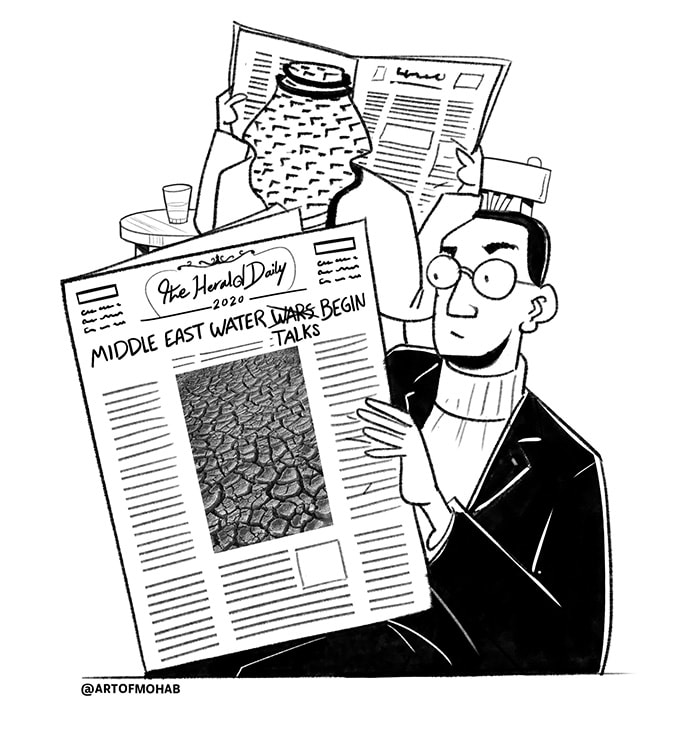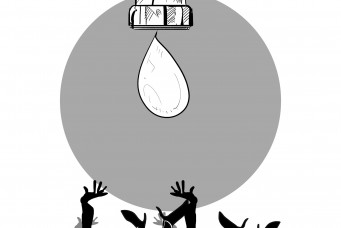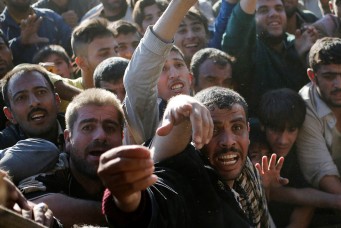Myths about Food Security and Water
Will water be the cause of the next war in the Middle East? Is water important for regional food security? Can economic diversification really work? Time to bust the myths around questions of food and water security in the region

Former UN Secretary-General Boutros Boutros-Ghali famously warned in 1988 that the next war in the Middle East and North Africa (MENA) would be over water—not oil. Since then, there have been a number of wars in the MENA region; however, none were over water. More often than not, water has encouraged cooperation between states, rather than conflict, albeit on uneven, hegemonic terms. Even when politicians have occasionally threatened to bomb the dams of upstream riparian countries or “defend every drop of Nile water with blood,” as did former Egyptian President Mohammed Morsi in 2013 when Ethiopia started construction on its Grand Ethiopian Renaissance Dam, nothing happened.
When it comes to feeding populations, water is not as important for food security as the rhetoric on hydro-politics in the Middle East may suggest. A trade-based approach to food security argues that as long as world markets stay open and countries make the necessary foreign exchange earnings to import food, they could become entirely food secure. However, important caveats remain regarding sanctions and war, which could affect food availability, as well as poverty and inequality, which could affect access of vulnerable populations to food that is theoretically available. All four caveats pose serious problems to Middle Eastern countries today.
Importing Food Sufficiency
The MENA region imports more than 50 percent of its calorie requirements and is the world’s largest importer of cereals. Besides cereals (mainly wheat and rice), it also imports a growing number of value-added products such as poultry and dairy. New trading partners have emerged, often from tropical areas. For example, Brazil exports billions of dollars in meat, poultry, sugar, cereals, and soya to the region while Indonesia and Malaysia are its main suppliers of palm oil. Gulf countries have an increased need to outsource alfalfa production for their domestic livestock industries as they phase out their own production because of depleting water resources. In recent years, Russia has become Egypt’s dominant supplier of wheat, taking over from North America.
International organizations such as the World Bank, and much of the academic analysis rooted in economic liberalism, often argue for a trade-based approach to food security. The approach embraces import dependence and stresses the importance of free trade, efficiency, and economic diversification in allowing countries to afford food imports. Oil-rich countries in the region with ample foreign exchange earnings face fewer challenges financing and facilitating food imports. They belong to the most food-secure countries regionally, even though they have low food self-sufficiency and no meaningful agricultural production capacity.
For countries with better agricultural resources such as Egypt, Turkey, and Morocco, the trade-based approach suggests that agricultural production should be switched from staple crops to luxury products such as fruits and vegetables, which yield more monetary value per drop of water used. According to this model, foreign exchange earnings derived from such exports would increase the ability of these countries to import and consume more items such as cereals in quantities that surpass their own domestic output if they focused their production capacity on cereals rather than on the recommended export cash crops. However, MENA politicians’ focus on irrigation projects threatens to crowd out attention for projects based on “green water,” or water that is not lost to runoff and stays in the soil. While domestic resources are overexploited, the region’s green water resources are underappreciated and could be harnessed more efficiently for use in sustainable rangeland management and livestock production. The type of self-sufficiency ambitions envisioned by MENA politicians clearly defies the trade-based approach to food security, which many of them must find unconvincing. Countries that are at risk of war, sanctions, and other supply disruptions, especially if they have larger populations, routinely display a preference for growing staple crops as a means of achieving at least some degree of self-sufficiency. Overall, concerns regarding food availability and security loom large in the conflict-prone region. During World War II, famines were only averted by the arrival of food supplies from the Allied Middle East Supply Center (MESC) in Cairo. Iraq, Syria, and Egypt produced an agricultural surplus that was distributed to food-deficient parts of the region such as Palestine and the Gulf.
By the 1970s, such surpluses had disappeared as agricultural production lagged behind population growth. All the more worrying was the growing politicization of the food trade by the United States, which threatened a food embargo in retaliation for the 1973 Arab oil boycott and used food aid in a carrot-and-stick policy to extract favors from recipient countries. Egypt had become the largest per capita recipient of U.S. food aid in the world by the mid-1960s. Its wheat imports accounted for almost a fifth of total imports, mostly subsidized and delivered under the American P.L. 480 food assistance program. It was a serious fiscal blow for Egypt when U.S. President Lyndon Johnson discontinued such deliveries in the mid-1960s over Egyptian President Gamal Abdel Nasser’s revolutionary foreign policy stance. P.L. 480 deliveries would only resume in the 1970s after the Egyptian–Israeli rapprochement and the signing of the Camp David Accords.
Sanctions later developed into a looming threat to food imports in the region. Between 1990 and 2003, Iraq fell under the most comprehensive sanctions regime since World War II, with disastrous consequences for food security. On the eve of its ill-fated invasion of Kuwait, it had imported about 70 percent of its supplies of cereals, legumes, oils, and sugar. Most of these supplies vanished. While food was formally excluded from sanctions, Iraq lacked the financial wherewithal to pay for it, as its oil exports were banned and its foreign assets frozen.
More recently, food exporters such as Argentina, Russia, and Vietnam sent shockwaves through the region in the wake of the 2008 global food crisis when they announced export restrictions out of concern for their own food security. The rich oil-exporting counties in the Middle East reacted by announcing large-scale agro-investments in often-food insecure countries such as Sudan and Pakistan. Such investments were a bid to bypass international markets and seek privileged bilateral access to food production. They were in themselves controversial, raising fears about “neo-colonial” land grabs, and the disenfranchisement of smallholders with customary land rights, which was indeed the issue in some cases.
On the other hand, most of the announced investments by Gulf countries never got off the ground, or were only implemented at a fraction of the announced scale, as harsh investment environments, environmental vagaries, corruption, and political resistance took their toll. So far, the land investments hardly contribute anything to the large food import requirements of Gulf countries. These continue to come from international markets, where they are procured via the large trading houses that are dominant players in the corporatized food regime of today, such as ADM, Bunge, Cargill, Louis Dreyfus, and Glencore.
Oil for Food and Economic Diversification
Geostrategic concerns notwithstanding, the MENA region’s dependence on food imports will not go away. On the supply side, mere technocratic solutions to tackle water scarcity and increase production such as improved irrigation efficiency will not suffice, and food demands will not catch up with the rapid population growth that is the case in many countries. More demand will additionally result from changing dietary trends that are becoming increasingly based on meat and dairy products and packaged foods—a shift which has occurred in the region as well as in the world.
The dependence on food imports raises the question of how MENA countries will continue to pay for them. As things stand, many economies in the Gulf, Libya, Algeria, and Iraq are highly dependent on oil exports, while most others such as Egypt and Jordan have an indirect dependence on recycled oil wealth via migrant remittances and strategic transfer payments that oil-rich Gulf countries make in return for foreign policy cooperation. Some countries such as Egypt were until recently hydrocarbon exporters themselves before oil fields matured and growing domestic demand eroded their export capacity, sometimes in combination with violent conflict and division of territory, as in the cases of Syria, Yemen, and Sudan.
Moreover, the region’s oil production capacity is not only dwarfed by growing domestic demand and declining production in some states, but also by the global oil market outlook. Oil prices have been declining since 2014 in the wake of the unconventional oil revolution in the United States, which has proven to be a major fiscal challenge for Middle Eastern states. A faster-than-expected uptick of electric mobility could cause a considerable decrease in demand in gasoline markets. In the long run, this could lead to a paradigm shift toward renewables that could permanently depress oil markets and lead to the abandoning of the region’s oil assets. On the other hand, diesel, kerosene, and fuel oil would still be needed for trucks, planes, and ships because of their high energy density, and other segments of the petroleum product markets, such as petrochemicals, will likely continue to grow since options for their substitution are limited.
The specter of rentier states without rents evokes scenarios of political instability. When this oil-for-food formula fails, the need for economic diversification to provide fiscal relief, jobs for the burgeoning youth population, and foreign exchange earnings for food imports will grow more urgent by the day. The dependence on volatile oil revenues has created economic uncertainties and has often led to a “resource curse,” defined by the misallocation of resources, the underdevelopment of non-oil sectors and human resources, a resource capture by elites, limited transparency, and shortcomings in the provision of public goods such as education.
Economic diversification in MENA states is a tall order in an age of jobless growth, competition from emerging markets in Asia, and a latent global financial crisis. These countries cannot just follow the lead of South Korea and others, which were able to embark on a course of industrialization and harvest a demographic dividend—a 1960s feat that is not that easy today, if at all possible. The economies of the region’s countries are also hampered by the low level of intra-regional integration, educational shortcomings, and limited endowments of raw materials, apart from oil, gas, and phosphates.
Yet, there are some examples of economic diversification that have borne fruit. Gulf countries had some success with diversifying into petrochemicals, heavy industry, and the logistics and services sectors in the case of Dubai. Renewable energies offered unique opportunities for the non-oil exporters in the region such as Morocco, which are unburdened by concerns over stranded hydrocarbon assets. Some countries in North Africa such as Tunisia, Egypt, and Morocco were able to attract manufacturing or offer opportunities for nature-based tourism.
Inconsistencies of the Water and Climate War Narrative
The debate on economic diversification—whether or not it can happen— not only points to the oil-for-food dilemma of import-dependent states, but also to the question of water wars raised by Botrous-Ghali—or rather, the misconception that the next big wars will center around water. Nobody speaks of water wars in California or southeast Australia, which are equally water-scarce. Yet, in the MENA region, this narrative has become all too common.
In recent years too, the water war narrative has been complemented by a climate war narrative of similar neo-Malthusian persuasion: the region’s populations have outstripped available water resources and agricultural production capacities; therefore, hunger and forced migration will lead to violent conflicts, and climate change will make it worse. The conflicts in Sudan’s Darfur and Syria have been marshaled as evidence. Others have criticized this climate war narrative for neglecting causes of conflict that are rooted in the political economies of the respective countries, such as crony capitalism and growing inequality in the wake of liberalization policies, rural neglect, and misguided water management.
The conceptualization of climate change as a “stress multiplier” of pre-existing socio-political conflicts can be contested. Primary political economy drivers of such conflicts are occasionally mentioned, but not dealt with as factors of war in the climate war narratives. Sometimes the use of water as a tool of warfare is confused with it being the reason for war. The Islamic State in Iraq and Syria (ISIS), for example, released water behind dams to thwart advancing Iraqi forces and temporarily withheld water or poisoned it with diesel to punish populations that opposed the group. This was war with water rather than for it. The use of water infrastructure was surely of strategic concern, but water does not lend itself to becoming war booty because of its characteristics. Unlike an oil well or a diamond mine, one cannot take lasting possession of it, nor does it make commercial sense to be in control of it: it is a bulky commodity whose long-distance transportation would be costly; to use it for electricity production means that it cannot be withheld; and one cannot hold it back indefinitely for coercive reasons, as dams will fill up sooner rather than later. Moreover, there is no “blood water” that would finance rogue militias.
While conflicts between states over water are rare or non-existent, local conflicts over such resources between pastoralists and herders or between irrigating communities have occurred. Connections have also been made between a moral economy of subsidized food (much of it imported) and political protests during the Arab Spring. Liberalization policies have hurt smallholders in Egypt and Syria’s farming population. The restive Rif region in Morocco is a disadvantaged rural periphery where people have carved out precarious farming livelihoods that depend on the illicit cultivation of hashish. The uprising in Tunisia emerged from the neglected hinterland of Gafsa. Much of the profits from phosphate mining there went to the coastal centers, and residents were left with environmental damage that affected agricultural production. Rural crises can affect state capacity and reinforce the limits of statehood in the periphery, contributing to tipping-point situations such as the self-immolation of Tunisian street vendor Mohamed Bouazizi that set off the Tunisian protests and the Arab Spring at large. Possible solutions to the water and food security challenge in the region should come from outside the rural sector; will need to include debates on economic diversification and inclusive development; and will come with trade-offs between water and food security that can be politically controversial, as farming communities might resist the downsizing of agriculture that would be necessary to save water.
Water scarcity and the impact of climate change do constitute major socioeconomic challenges for MENA countries. However, whether countries are able to cope with such pressures or whether they contribute to existing socio-political grievances and conflicts depend on the adaptive capabilities of the countries and sub-regions. These include the role and contribution of agricultural production to employment and overall gross domestic product, the level of economic diversification and political participation pursued, and the building of infrastructure and proper institutions and safety nets, just to mention a few. Evaluating such factors can help policymakers anticipate whether water scarcity will lead to bigger conflicts, but projections of war made thus far in water and climate war narratives have been misguided.
Improving Food and Water Security
Managing import dependency in MENA countries is one approach to finding food security. While food self-sufficiency is unattainable, domestic agriculture offers considerable room for improvement through making better use of the region’s green water resources. Areas where rain-fed farming is possible with or without supplemental irrigation should receive special attention. Sustainable management of pastures and livestock production is another aspect. Such changes could also have a meaningful impact in the fight against desertification in places like Iraq, where currently the expansion of wheat production is prioritized. Food security debates will also need to tie more into the broader debates on inclusive growth, economic diversification, energy transitions, and the sustainability of recycling oil rents in the region’s economies.
Moreover, improving food security in the region primarily means addressing inequality when it comes to access to food. On a country level, wealth inequality is much higher than income inequality, and there is significant underreporting of ownership of large assets. Intra-regionally, the region has the highest income inequality worldwide because of huge disparities between resource-rich and resource-poor countries. Food accessibility for significant parts of populations can be compromised by such inequalities.
All in all, limited arable land and water resources as well as rapid population growth mean that the future of MENA’s food security will likely remain centered on imports. Managing import dependence and the growing urbanization in the region will involve the management of value chains and related infrastructure such as roads, storage, and cooling chains. Strategic vulnerabilities that come with a higher dependence on imports can also be managed by diversifying trading partners and developing storage solutions. Finally, violent conflict, displacements, and the use of food as a weapon of war in Syria, Yemen, Sudan, and Iraq belong to the foremost food security challenges in the Middle East region today. Such conflicts and associated food insecurities are manmade; water scarcity and agricultural shortcomings can hardly be blamed for them.
Some parts of this essay have been adapted from a working paper titled “Water and Food Security in North Africa and Possible Implications for Areas of Limited Statehood” for the EU-funded EU-LISTCO project.
Eckart Woertz is director of the Institute of Middle East Studies at the German Institute of Global and Area Studies in Hamburg and professor for contemporary Middle East history at the University of Hamburg. He is the author of Oil for Food and numerous journal articles on development issues in the Middle East. On Twitter: @eckartwoertz.
Read More




